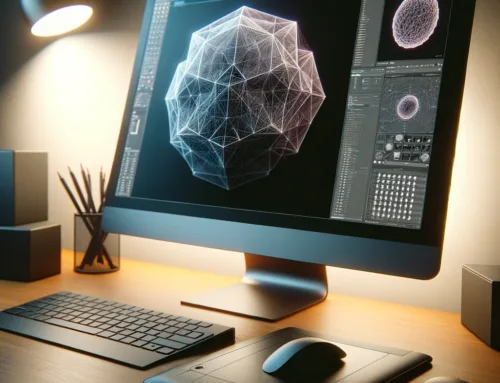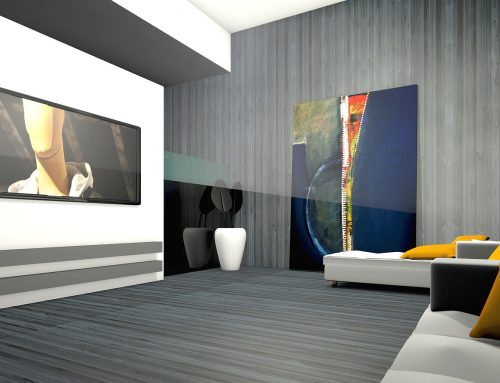Einsteigerguide: Stärken und Anwendungsgebiete von Modo.
Es gibt keine 3D-Software, die anderen in all ihren Aspekten überlegen ist. In der Praxis können interessante Diskussionen über verschiedene Software-Lösungen beobachtet werden, aber dennoch kann das alte CGI-Sprichwort „Der Designer ist für die Qualität verantwortlich und nicht die Software“ bestätigt werden. Dennoch stößt man recht häufig auf Foren-Threads, in dem Software-Nutzer die Überlegenheit des einen oder anderen Programms thematisieren und leider kann allzu oft nicht mehr zwischen „Designer“ und „Programm“ differenziert werden. Es gibt allerdings nicht das beste Programm, dass in jeder Situation universal eingesetzt werden kann. Vielmehr eignen sich bestimmte Softwarelösungen je nach Nutzer und Situation besser oder weniger gut.

In dem folgenden Artikel werden wir mögliche Anwendungsgebiete und Stärken der 3D-Software Modo thematisieren.
Geschichte von Modo.
Modo wurde von namhaften Developern von NewTek`s LightWave entwickelt, nachdem man sich über eine Überarbeitung des Programms nicht einig war. Modo ist eine komplette 3D-Suite, die aus der Notwendigkeit geboren wurde, eine ganzheitliche und effiziente 3D-Lösung zu entwickeln. Früher von Luxology LLC entwickelt, wird Modo nun von „The Foundry“ entwickelt, die auch für populäre Software wie NUKE, MARI und Katana verantwortlich ist. Modo hat sich neben der Compositing– und Managementsoftware von Foundry einen Namen in der VFX- und Filmproduktion gemacht und wird von namhaften Persönlichkeiten der Branche als zuverlässiges Werkzeug zur Pre-Visualisierung und Erstellung von Assets geschätzt.
Und nun ein Blick auf einige der wichtigsten Funktionen von Modo.
Preisgestaltung.
Die Abonnementkosten von Modo belaufen sich auf ca. 600 € im Jahr, was im Vergleich zu anderen beliebten 3D-Programmen wie C4d oder 3ds Max recht günstig ist ist.
The Foundry bietet auch Education-Lizenzen für Studenten und Institutionen für nur 156 bzw. 188 US-Dollar an und eine 30 tägige Testversion von Modo kann heruntergeladen werden, einschließlich Schulungsmaterial für den Einstieg.
Lernkurve.
Die Intuitivität eines Programms ist weitgehend subjektiv, da der Workflow für andere, die anders vorgehen, vielleicht nicht so schnell zu erfassen ist, aber die Fülle der online für Modo verfügbaren Ressourcen sollten Sie ganz gut unterstützen.
Die Community-Seite von „The Foundry“ ist gefüllt mit Tutorial-Videos für Modo und hat eine sehr aktive Benutzerbasis. Das Lernen aus diesen Videos und das Stellen von Fragen im Forum allein ist eine gute Möglichkeit, sich schnell mit der Software vertraut zu machen, aber es gibt auch auf YouTube eine Menge Trainingsvideos. Sie können auch einer lebendigen Modo-Community auf Facebook beitreten und mit Benutzern interagieren, Feedback für ihre Arbeiten erhalten und die vielen praktischen Tutorials und Tipps von William Vaughn auf seinem Vimeo-Kanal lesen.
Modo etablierte sich eine zeit lang als das Tool des Modellbaus. Seine Modellierungswerkzeuge sind bekannt dafür, dass sie sowohl für die direkte als auch für die prozedurale Modellierung geeignet sind, die immer wieder als reibungslos und intuitiv beschrieben wurden, aber darunter liegt ein ausgeklügelter Workflow, der die Arbeit mit Meshes und ihren Komponenten wirklich effizient gestaltet.
Die Arbeitsebene ist zum Beispiel die Art und Weise, wie Modo ihnen kommuniziert, welches Koordinatensystem in einer Szene verwendet wird. Die Modellierung wird schwierig, wenn Sie beginnen, an Teilen eines Meshes zu arbeiten, die sich nicht innerhalb der Hauptachsen befinden, aber mit einem einfachen Hotkey können Sie die Arbeitsfläche von Modo zum Beispiel an ein Polygon fangen und weiterhin im Koordinatenraum dieses Polygons erstellen.
Modo verfügt über eine Vielzahl von Auswahlwerkzeugen, die die Auswahl von Meshkomponenten und den Meshes selbst schnell und einfach machen. Sie können ein Muster mit abwechselnden Kanten auswählen, die gemusterte Auswahl mit der Taste UP vergrößern und mit der Taste L die Schleifen dieser Kanten auswählen. Falloff-Deformer ermöglichen es ihnen, Selektionen zu konfigurieren und Meshkomponenten skulturaler zu bearbeiten. Sie können auch verschiedene Objekte in der Szene mit einer Vielzahl von Optionen mit dem Werkzeug Select Pattern auswählen.
Geometriebeschränkungen bieten mehrere Möglichkeiten, ein Mesh an ein Mesh in den Hintergründen zu knipsen, basierend auf einem Index einer seiner Komponenten.
MeshFusion ermöglicht es ihnen, in Echtzeit boolesche Operationen an Subdivision Surface Meshes durchzuführen und diese anschließend über ein Node-Netzwerk prozedural zu bearbeiten, was die Modellierung harter Oberflächen zu einem Kinderspiel macht. Sie können boolesche Rollen für eine beliebige Anzahl von Meshes, die Teil der „Fusion“ sind, ändern, ein Mesh in ein anderes ziehen und einer Operation aus einem Dropdown-Menü zuweisen, das Profil des Schnittbereichs zwischen zwei Meshes bearbeiten und mit einer einfachen Hotkey-Kombination (Strg + F) auf Presets aus einem Kreismenü zugreifen.
Modos Topologie-Pen ist ein bekanntes Werkzeug zur Retopologisierung von gemeißelten Meshes und zur schnellen Darstellung des Polygonkantenflusses. Mit den damit verbundenen Hotkeys können Sie Schleifen mit einem Grad an Intuitivität erstellen, die es ihnen ermöglichen, sich darauf zu konzentrieren, bessere Wege zu finden, um ihre Topologie zu verbessern. Modo kommt auch mit einem Auto-Repologie-Tool, das quad-basierte Meshes aus ihren Sculpts mit wenigen Klicks erzeugt.
Texturierung und Shading.
Sie können eine Vielzahl von Matten und Texturen verwenden, um ihre Modelle besser vorab zu visualisieren, ohne sie entpacken und beschatten zu müssen. Funktionen wie die Texturebene Variation ermöglichen es ihnen, verschiedene Werte auf ihre Meshes anzuwenden, die auf mehreren Parametern basieren, wie z.B. Meshteile, Partikel oder Elemente (Objekte).
Modos Textur-Painting-Toolset ermöglicht die gleiche Art von Werkzeug-Interoperabilität wie bei der Modellierung. Benutzerdefinierte Pinsel, Schablonen, Height Maps von Meshes, Nozzle Optionen für Grafiktablets und mehr stehen ihnen zur Verfügung und zwar mit einer Reaktionsfähigkeit, die es ermöglicht, jede Änderung sofort auf dem Ansichtsfenster als auch auf dem Preview-Renderer anzuzeigen.
Der Shader-Tree operiert auf einer ebenenbasierten Hierarchie ähnlich wie in Photoshop, aber mit jeder Ebene können Sie schnell zwischen bestimmten Shading-Attributen für die Ansichtsvorschau umschalten, Materialebenen einfach Elementen oder Mesh-Komponenten zuweisen und darüber hinaus verfügt Modo über eine schöne Sammlung von Presets für die schnelle und einfache Definition von Oberflächen für ihre Modelle.
Die Rigging- und Animationsfunktionen von Modo sind nicht zu vernachlässigen.
Der nodebasierte Rigging-Workflow von Modo macht es einfach, komplizierte Rigs vorzubereiten und bei Bedarf wiederzuverwenden. Die Aktivierung von „Intersection“ beim Erstellen von Verbindungen mit dem Skelettwerkzeug ermöglicht es ihnen, Nodes auf ihrem Charakter schnell zu plotten, indem Sie sie in die Mitte des Volumens jedes Teils des Meshes schnappen, auf das sie angewendet werden. Die Weight-Container von Modo ermöglichen es ihnen, Gewichte auf Elemente außerhalb ihres Meshes abzubilden, die dann als Weight-Maps für andere Meshes dienen können.
Die Setup-Funktion im Rigging ermöglicht es ihnen, Rig-Anpassungen unter Beibehaltung ihrer Animationen durchzuführen und die Funktion zur Reihenfolge der Operationen ermöglicht es ihnen, ihre Morph-Deformationen zu verschieben, ohne andere Morph-Werte zu beeinträchtigen, nach denen Sie gesucht haben.
Mit dem Modo-Animationssystem für Schauspieler, Pose und Action können Sie auf lichtlineare Weise animieren, indem Sie Clips und Posen austauschen, um verschiedene Szenen anzupassen.
Praktisch alle Attribute oder Kanäle von Modo sind animierbar, wodurch langwierige Prozesse umgangen werden, die in anderer Software durchgeführt werden müssen, wie z.B. die Animation zwischen aktiven Renderkameras.
Rendering.
Modos native Rendering-Engines soll in kürzester Zeit atemberaubende Ergebnisse liefern als bei externen Render-Engines und verwendet seit Release 10 physikalische realistische Materialien. Dies bedeutet jedoch nicht, dass Modo nicht mit Industriestandardmotoren verwendet werden kann. Renderer wie V-Ray und Octane unterstützen Modo vollständig. Weitere interessante Funktionen in Modos Rendering-Toolset sind Passes und Pass Groups. Eine Pass Group kann beliebig viele Passes enthalten, die unterschiedliche Werte für zugewiesene Kanäle speichern, d.h. Sie können zwischen mehreren Iterationen ihrer Szenenelemente wechseln und diese Interationen nach ihren Wünschen organisieren. Stellen Sie sich vor, wie viel schneller ihre Turnarounds sein könnten.
Unterstützung durch Drittanbieter von Rendering-Dienstleistungen.
Viele Modo-Renderfarmen sind auf dem Markt verfügbar und der große Wettbewerb bedeutet wettbewerbsfähige Preise und ein hohes Maß an technischer Unterstützung. Dieser Faktor ist integraler Bestandteil der Einschätzung eines ernsthaften Designers, in welches Programm zu investieren ist, da professionelle Arbeit oft unter sehr engen Fristen abläuft, was ohne die Beschaffung einer Renderfarm oder hoher Investitionen in Hardware schwer zu bewältigen wäre. Die meisten Modo-Farmen unterstützen den nativen Renderer und Funktionsumfang, Plugins und externe Renderer von Modo. Wir persönlich lieben das Asset Management von Modo, das in Zeiten der Fehlersuche und des Testens für uns ein echter Zeitgewinn sein kann.
Plugins.
The Foundry und ihre Partner stellen viele nützliche Plugins zur Verfügung, die die bereits umfangreichen Funktionen von Modo ergänzen und die erforderlichen Funktionen hinzufügen, um andere Aspekte des Programms zu erweitern. Die enge Zusammenarbeit zwischen „The Foundry“ und Drittanbietern stellt sicher, dass Plugins mit den neuesten Modo-Versionen auf dem neuesten Stand sind, gut dokumentiert und getestet werden, aber die Tatsache, dass der Kernfunktionsumfang von Modo mehr ist, als Sie normalerweise benötigen, kann nicht oft genug wiederholt werden.
Also, ist Modo etwas für Sie?
Wenn Sie auf der Suche nach einem Tool sind, das die Arbeit auf intuitive und effiziente Weise erledigt, in der Lage ist, schneller Wiederholungen eines Konzepts in 3D herauszuholen, reaktionsschnell ist und ein gutes Preis-Leistungsverhältnis bietet, ist Modo eine gute Wahl. Wenn Sie auf der Suche nach einem Programm mit einer aktiven Community und vielen verfügbaren Lernressourcen sind, können Sie mit Modo auch nichts falsch machen. Es ist ideale Wahl für jeden, der als Modellierer, Konzeptdesigner oder Industrievisualisierer arbeitet und kann eine gute Lösung für Sie sein, wenn ein Design- oder Illusionsauftrag eine anspruchsvolle Bearbeitungszeit hat. Wenn Sie mehr über diese nützliche Engine erfahren möchten, werfen Sie einen Blick auf das PixelFondue, das von William Vaughn und seiner Firma betrieben wird und vollgepackt ist mit prägnanten und nützlichen Tipps sowie Einblicken in die vielen Funktionen von Modos.
Vielen Dank für ihren Besuch.


